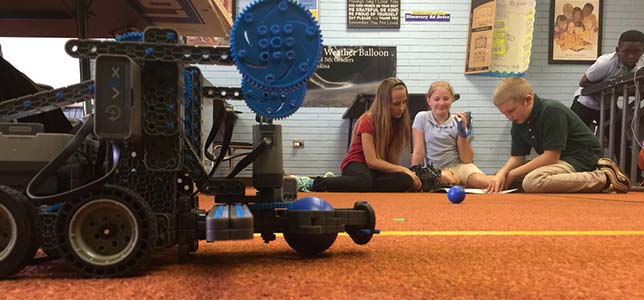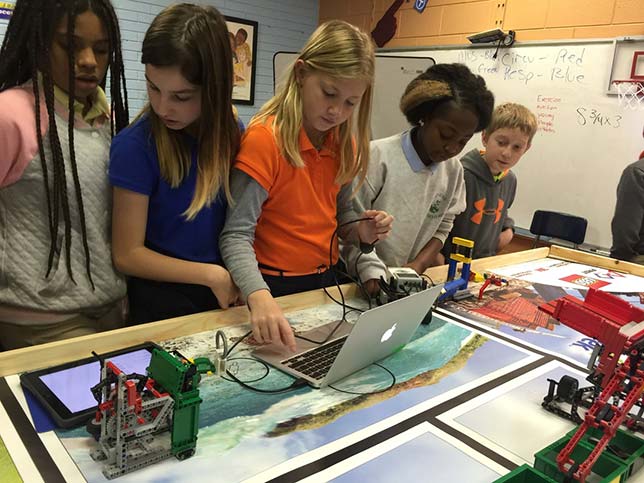As Pedagogy Changes, Learning Spaces Are Transforming Too
The American architect Louis Sullivan coined the phrase "form follows function," and this is true of classrooms as well.

As a student, Anthony Johnson hated school. He hated sitting still at one of several cramped desks aligned in precise rows, listening to his teachers talk for hours. It's why he dropped out of school before ultimately earning a GED, going on to college and becoming a teacher himself.
"My own experience in school was awful," he said, "and I decided that my classroom wasn't going to look like that."
In Johnson's classroom at H.D. Isenberg Elementary School in Salisbury, NC, students can choose from a variety of seating options. There are tables for students to collaborate in groups of four, as well as bar-style seating on taller stools and even a few couches where they can sit comfortably while they work or read independently. The school provided the tables, and Johnson supplied the rest of the furniture himself.
To teach his students about citizenship, Johnson operates his classroom like a community. "I call it the Johnsonville Learning Community," he said.
His fourth- and fifth-grade students can earn currency by coming to class each day and successfully completing assignments, and they also hold various classroom jobs. "The students who keep the classroom clean are part of our janitorial service," he explained. "The student who brings things to the office is our delivery service." Students use part of their currency to pay "rent" each month, and that entitles them to sit where they want.
Johnson's school system is a 1-to-1 district, and every student is given an iPad to take home. Much of his instruction is project-based, with students working in small groups on tasks using curriculum from sources such as Defined STEM. In one recent project, his students used 3D modeling software on their iPads to create a multi-touch book about the human body systems.

Design Matters
Johnson's classroom is an example of how changes in both the design of the learning space and the teaching that takes place there have combined to making learning much more engaging and effective for students.
A growing body of research suggests that the design of a learning space can have a significant effect on student success. For instance, a study by researchers at the University of Salford in England found that classroom design can have a 25 percent impact, either positive or negative, on student achievement over the course of an academic year — with factors such as color, complexity, flexibility, lighting and student choice having the most influence.
At the 2017 International Society for Technology in Education (ISTE) conference in San Antonio, a number of sessions focused on redesigning classrooms to make them more engaging and inviting.
April DeGennaro, a K-5 gifted education teacher in Fayette County, GA, co-chairs the professional development committee for ISTE's Learning Spaces Network. During the ISTE conference, she discussed how her school system is shifting from traditional industrial-style classrooms with desks arranged in rows to more flexible learning spaces that encourage the development of 21st-century skills.
Fayette County began with five pilot schools, DeGennaro said. The leadership teams at each of these schools were involved in designing their own model learning spaces in conjunction with professional designers. The resulting spaces incorporated soft seating options, areas for collaboration and more vibrant colors — and students were excited by the results. "Students tell me they love being able to move around and even lie down while they're learning," she said.
But redesigning learning spaces won't amount to much without changing instructional practices as well. Quoting her superintendent, Joseph Barrow, DeGennaro said: "When we get the intersection of utilizing flexible learning spaces and implementing personalized student learning, we have designed a great 'secret sauce.'"
Focus on the Learning
David Jakes, a former educator and administrator who now helps schools transform their learning spaces, encouraged ISTE 2017 attendees to develop a new mindset and lens through which to visualize the possibilities for today's classrooms.
"We have neglected our learning spaces for a long time," he said. "The first step in redesigning the classroom is to discard the notion that it has to be a classroom because that comes with baggage. What about imagining it as a studio instead?"
When redesigning learning spaces, let the type of learning experiences you want to foster be your guide, Jakes advised. "Focus on experiences, not things," he said. "This is not about furniture; it's about the learning. What experiences do I want to create for students? Then, what design would support that?"
The American architect Louis Sullivan coined the phrase "form follows function," and this is true of classrooms as well. A classroom with rows of student desks facing the front of the room creates a teacher-centric space that implies students are expected to sit and listen as the teacher talks. But a classroom with students sitting facing each other in small groups encourages a more active, student-centered style of learning, powered by teamwork and collaboration.
It's important to have a space that can assume many different roles, Jakes said, depending on the kinds of learning going on. He used the word "agile" to describe the ideal classroom: a flexible and dynamic learning space where the furniture can be rearranged quickly to support various activities. Several classroom furniture makers, such as Paragon, Smith System and Steelcase, make desks and tables that easily can be arranged into creative groupings of multiple sizes.
Although Johnson's classroom at Isenberg Elementary doesn't contain such agile furniture, he said the configuration of his classroom changes based on the activities that students are working on.
"The kids love it," he said. "They look forward to coming to class. It's a more welcoming environment than the classrooms I grew up in — and they see me as a facilitator of their learning."
About the Author
Dennis Pierce is a freelance writer with 17 years of experience covering education and technology. He can be reached at [email protected].